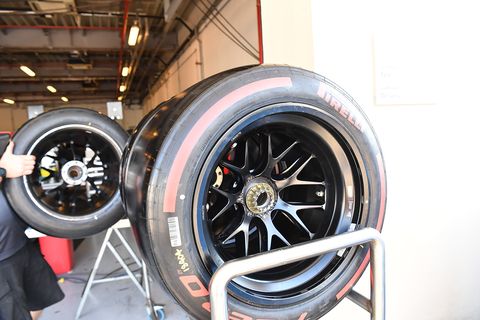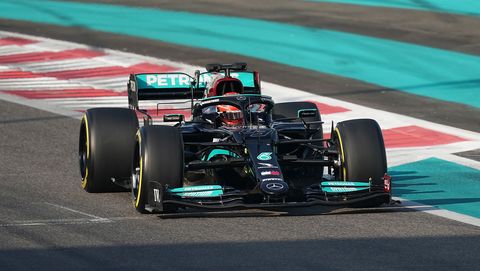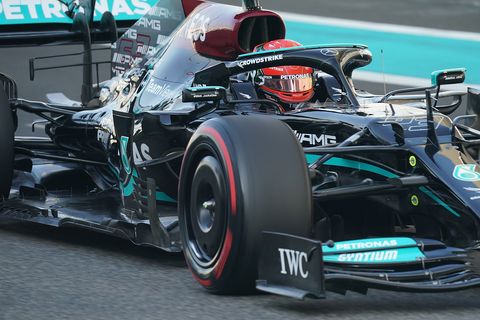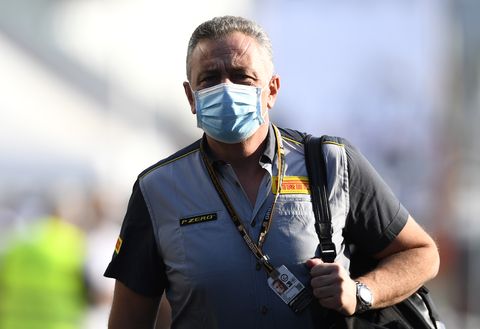Why Formula 1 Is Going to 18-Inch Tires, and What to Expect
- Formula 1’s move from 13-inch to 18-inch tires was pushed back from 2021 to 2022 due to the COIVD-19 pandemic.
- Pirelli says the 18-inch tire is good for technology transfer from race to road, because the sizes are a lot more relevant compared to the 13-inch.
- Pirelli has to create five dry-weather compounds—along with the wet-weather Intermediates and Wets—of which three are selected for each Grand Prix.
Formula 1’s tires will undergo a transformation for 2022.
Gone are the 13-inch tires that have been present for decades, and in their place come 18-inch tires, again provided by sole supplier Pirelli, which has held the role since 2011. The new sizes are part of the wide-ranging technical changes being introduced for 2022.
“It was a decision made based on the new package,” said Pirelli’s Formula 1 boss Mario Isola. “The 18-inch tires are probably the most visible part of the car. It is part of an idea coming from F1 to make F1 more modern, with the possibility to have closer action on track.
“We are obviously very happy as moving to an 18-inch tire is good for our technology transfer from race to road, because the sizes are a lot more relevant compared to the 13-inch.”
It has been a challenging development program for Pirelli, which began in mid-2019, and was then prolonged when the pandemic prompted unanimous agreement for the new regulations to be deferred from 2021 until 2022.
Pirelli has to create five dry-weather compounds—along with the wet-weather Intermediates and Wets—of which three are selected for each Grand Prix. It works to a target letter agreed with major stakeholders Formula 1 and the FIA, which includes desirable elements such the delta between compounds and the strategic ambition. Pirelli thus has to consider different car performance, which evolves as clever designers unearth more lap time, 23 circuits with varying characteristics and demands, and temperature fluctuations.
Furthermore, regulations dictate that each driver per weekend has eight Softs, three Mediums and two Hards; and one of the Medium or Hard must be run in race trim. Getting tire compounds that are just right, and which have sufficient lap time and degradation differences to produce offset strategies so that everyone doesn’t converge to the same approach… talk about a tough task.
“We had to redesign not only the construction, the profile, but also the range of compounds,” said Isola. “In the target letter we agreed with the stakeholders we have a number of parameters that are different to 2021, and previous seasons,” said Isola. “The delta lap time has been reviewed and the level of degradation as well, with these numbers we should have a mix of one to two stops in the races.”
Testing has been ongoing since mid-2019 using that season’s cars slightly modified in order to accommodate the revised tire sizes. Only Williams, which was not in a financial position to commit to extra testing, has been absent; Pirelli is allocated 25 days test per year that is split between teams, which usually supply race drivers, and the company provides the run program. Data and information gathered is distributed to all teams equally to ensure there is no advantage.
For 2022, part of the target letter involves a desire for the tires to have a wider operating window, and be more robust in race trim, but it remains a difficult science to accurately assess.
“To confirm that the new tires have less overheating we told the drivers in the long runs to push without any saving or without any management,” said Isola. “And they did it and their feedback was, ‘I can push more, I can feel the grip staying there for a lot of laps’, whereas with the current tires they had to manage a lot more.
“When the drivers tell you there is less overheating because ‘I can push and drive more aggressively and still have the grip and still see the lap time’, that’s the best feedback we can have. But there is one element we cannot reproduce in testing, and that is traffic, as we have only one or two cars on track.”
However, the debut of the new 18-inch tires coincides with Formula 1’s revised aerodynamic regulations. Part of the problem in recent seasons has been drivers struggling in the turbulent wake created by the car ahead due to the massive downforce levels produced. The new regulations aim to tackle that by relying less on the over-complicated wings and aero devices for downforce. The so-called ‘dirty air’ should be significantly reduced.
“I’m confident with the new aero package we can improve that (tire issues), as if when you follow the car in front you will lose maximum 10{e3fa8c93bbc40c5a69d9feca38dfe7b99f2900dad9038a568cd0f4101441c3f9} downforce not 40{e3fa8c93bbc40c5a69d9feca38dfe7b99f2900dad9038a568cd0f4101441c3f9} it is a different story,” said Isola. “If the drivers lose downforce, they lose performance. And if they lose downforce, they start sliding. And if they slide, they start overheating the surface of the tire and they lose grip—so it’s a double effect.
“If they still have the downforce and the tire is pushed on the ground and it doesn’t slide then you can keep the surface temperature in range and can attack more. So hopefully with the aero package and the new tire we can achieve the result—not necessarily more overtaking as the car in front also has less degradation, but it means we have closer racing overall.”
The phrase ‘keeping the tire in the right window’ has oft been trotted out in explaining subdued performances by teams; it is hoped that potential set-up headache will be eased in 2022, if not diminished entirely.
“When we are defining the working range, the working range is defined by the top of grip minus a certain percentage,” said Isola. “So the grip is always on a curve. You can design a curve that is peakier, or a curve that is a lot flatter. But you have a peak in both cases. We have to accept from the peak of grip, there is a decrease of grip over certain percentage, and this defines the working range.
“We can say that the working range defined for next year’s compounds is wider but if you want to operate the tire exactly in the peak of grip then it is still difficult. If you move from the peak, you feel less loss of grip compared to the current tires because of the shape of the curve. But when you have a qualifying session when 10 cars might be fighting over two or three tenths of a second, then staying closer to the peak of grip will make a difference.”
Finding the right compromise for everyone can also be challenging when developing the products.
“We have to design a tire that is good for everybody, so I like to say it is a good compromise,” says Isola. “If you test the same tire with a top team, or a team that is at the end of the classification, they can say ‘ah the warm-up is fantastic’, or ‘the warm-up is tricky’, as they don’t generate downforce to put energy into the tire and therefore one is suffering warm-up and one is suffering overheating more, so it’s always the best compromise.
“The other point is circuits: high severity, low severity, we classify the circuits as we cannot test on 23 circuits and we cannot test on street circuits. We talked about delta lap time: in the target letter it is written that between compounds it should be half a second as an average, but in Spielberg the lap time is one minute and in Spa you are close to two minutes; you have a 5 km circuit, a 7 km circuit, so the delta lap time cannot be half a second, it is probably three tenths in Spielberg and eight tenths in Spa.”
And, of course, producing different products for all 23 circuits is unrealistic.
Formula 1 drivers had their first proper taste of the 18-inch tires in the official post-season Abu Dhabi test in mid-December. 16 of the 20 race drivers for 2022 tested (Lewis Hamilton, Nikita Mazepin and the Williams drivers were absent), as they tired out the new tires in the 2019 mule cars. There were caveats: the two hardest compounds (C1s and C2s) are not particularly useful at Yas Marina, due to the nature of the layout, while next year’s cars will of course be different.
There were still some takeaways.
“It’s challenging for us drivers and I think it will be more challenging next year to drive those cars overall,” said Ferrari’s Charles Leclerc. “It has probably a bit of a bigger window to work, especially in cold conditions, but it’s also quite tricky whenever you lose the car in the high speed especially.”
“It’s very different, I think you can push the car in different places compared to before,” said Alpine’s Esteban Ocon. “The 13-inch had good grip on the brakes but now the 18-inch you can roll more speed into the corner but you have to brake a bit earlier, things like this, you are not pushing exactly in the same places.”
“It’s going to be a different driving technique but I think during the winter we’ll get used to it,” said two-time champion Fernando Alonso, who raced larger profile tires during his sportscar sojourn. “I think we will experiment a bit, the load you put on the tyres is different, they behave differently at higher speed than lower speed.”
Drivers also had to get used to the slightly different view, with the new tires larger and thus making seeing the curbs harder, while overall there is an 11 kg weight gain from the four tires: 2.5 kg front, 3 kg rear. A few drivers tried out the new wheel covers, which may feature LEDs for potential sponsorship purposes, but knowing the effect of these so far is tricky due to the different aerodynamics and braking systems for 2022.
Pirelli estimates the new package will be around 0.5 second per lap slower than the 2021 cars, but that the rate of development means they’ll soon be quicker.
It is not the first time Pirelli has changed its products. In 2011 its directive was to produce high degrading tires that created multiple stops—sometimes as many as four per race—with massive performance drop-off. In 2014 it had to adapt to the hybrid power units that delivered torque in a different manner. In 2017 it introduced wider rear tires while over the years the desire for high degrading tires waned in favor of more durable rubber.
The 2022 campaign is another step. It is not an easy job being the sole supplier where perfection is demanded and any errors—such as failures this year in Azerbaijan and Qatar—heavily scrutinized.
“As any other part of the car you can have situations that you have to manage: deflation or tires that fail,” said Isola. “Our priority is safety. We test all of our tyres before going on track with indoor test machines to test integrity. It is a challenge—even if we don’t have a competitor—it is a challenge, because the product has to be exactly the same for everybody, so we need a consistency in production that is at a very high level, because we have to provide the same level of service.
“And, we have to update the product every year to keep with the speed of development of the cars, so there are many elements that we have to look after. When everything is going well it’s normal, when there is a problem the blame is on us, but this is part of the job, and what is important is to avoid anything like that happens.”
And the challenges will continue. Just as with automotive manufacturers, Pirelli wants to develop its tires in line with technical advancements and ensure the race track is a laboratory for the road. Its decade in Formula 1 has given it vital advancements in materials, manufacturing and simulations.
And already it can look to the next step: in 2023 tire blanket temperatures will reduce further ahead of their planned outlaw for 2024—the year in which Pirelli’s current contract expires.
The work never stops.
This content is created and maintained by a third party, and imported onto this page to help users provide their email addresses. You may be able to find more information about this and similar content at piano.io




